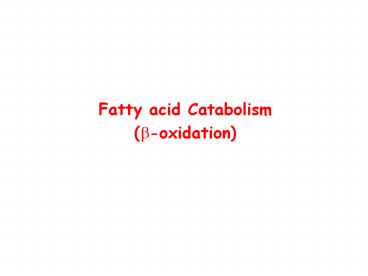Fatty%20acid%20Catabolism - PowerPoint PPT Presentation
Title:
Fatty%20acid%20Catabolism
Description:
The 2-C units are released as acetyl-CoA, not free acetate ... Acyl-CoAs are converted to acyl-carnitines by carnitine acyltransferase. ... – PowerPoint PPT presentation
Number of Views:191
Avg rating:3.0/5.0
Title: Fatty%20acid%20Catabolism
1
- Fatty acid Catabolism
- (b-oxidation)
2
(No Transcript)
3
Beta Oxidation of Fatty Acids
- Process by which fatty acids are degraded by
removal of 2-C units - b-oxidation occurs in the mitochondria matrix
- The 2-C units are released as acetyl-CoA, not
free acetate - The process begins with oxidation of the carbon
that is "beta" to the carboxyl carbon, so the
process is called"beta-oxidation"
4
Fatty acids must first be activated by formation
of acyl-CoA
- Acyl-CoA synthetase condenses fatty acids with
CoA, with simultaneous hydrolysis of ATP to AMP
and PPi - Formation of a CoA ester is expensive
energetically - Reaction just barely breaks even with ATP
hydrolysis DGoATP hydroysis -32.3 kJ/mol, DGo
Acyl-CoA synthesis 31.5 kJ/mol. - But subsequent hydrolysis of PPi drives the
reaction strongly forward (DGo 33.6 kJ/mol)
5
(No Transcript)
6
Import of acyl-CoA into mitochondria
- b-oxidation occurs in the mitochondria, requires
import of long chain acyl-CoAs - Acyl-CoAs are converted to acyl-carnitines by
carnitine acyltransferase. - A translocator then imports Acyl carnitine into
the matrix while simultaneously exporting free
carnitine to the cytosol - Acyl-carnitine is then converted back to acyl-CoA
in the matrix
7
Deficiencies of carnitine or carnitine
transferase or translocator activity are related
to disease state
- Symptons include muscle cramping during exercise,
severe weakness and death. - Affects muscles, kidney, and heart tissues.
- Muscle weakness related to importance of fatty
acids as long term energy source - People with this disease supplement diet with
medium chain fatty acids that do not require
carnitine shuttle to enter mitochondria.
8
b-oxidation
- Strategy create a carbonyl group on the ?-C
- First 3 reactions do that fourth cleaves the
"?-keto ester" in a reverse Claisen condensation - Products an acetyl-CoA and a fatty acid two
carbons shorter
9
b-oxidation
- B-oxidation of palmitate (C160) yields 106
molecules of ATP - C 160-CoA 7 FAD 7 NAD 7 H20 7 CoA ? 8
acetyl-CoA 7 FADH2 7 NADH 7 H - 2.5 ATPs per NADH 17.5
- 1.5 ATPs per FADH2 10.5
- 10 ATPs per acetyl-CoA 80
- Total 108 ATPs
- 2 ATP equivalents (ATP? AMP PPi, PPi ? 2 Pi)
consumed during activation of palmitate to
acyl-CoA - Net yield 106 ATPs
10
Acyl-CoA Dehydrogenase
- Oxidation of the C?-C? bond
- Mechanism involves proton abstraction, followed
by double bond formation and hydride removal by
FAD - Electrons are passed to an electron transfer
flavoprotein, and then to the electron transport
chain.
11
Acyl-CoA Dehydrogenase
12
Enoyl-CoA Hydratase
- aka crotonases
- Adds water across the double bond
- Uses substrates with trans-D2-and cis D2 double
bonds (impt in b-oxidation of unsaturated FAs) - With trans-D2 substrate forms L-isomer, with cis
D2 substrate forms D-isomer. - Normal reaction converts trans-enoyl-CoA to
L-?-hydroxyacyl-CoA
13
X
14
Hydroxyacyl-CoA Dehydrogenase
- Oxidizes the ?-Hydroxyl Group to keto group
- This enzyme is completely specific for
L-hydroxyacyl-CoA - D-hydroxylacyl-isomers are handled differently
- Produces one NADH
15
Thiolase
- Nucleophillic sulfhydryl group of CoA-SH attacks
the b-carbonyl carbon of the 3-keto-acyl-CoA. - Results in the cleavage of the Ca-Cb bond.
- Acetyl-CoA and an acyl-CoA (-) 2 carbons are
formed
16
b-oxidation of odd chain fatty acids
- Odd chain fatty acids are less common
- Formed by some bacteria in the stomachs of
rumaniants and the human colon. - b-oxidation occurs pretty much as w/ even chain
fatty acids until the final thiolase cleavage
which results in a 3 carbon acyl-CoA
(propionyl-CoA) - Special set of 3 enzymes are required to further
oxidize propionyl-CoA - Final Product succinyl-CoA enters TCA cycle
17
b-oxidation of unsaturated fatty acids
- b-oxidation occurs normally for 3 rounds until a
cis-D3-enoyl-CoA is formed. - Acyl-CoA dehydrogenase can not add double bond
between the a and b carbons. - Enoyl-CoA isomerase converts this to trans- ?2
enoly-CoA - Now the b-oxidation can continue on w/ the
hydration of the trans-D2-enoyl-CoA - Odd numbered double bonds handled by isomerase
18
b-oxidation of fatty acids with even numbered
double bonds
19
Ketone Bodies
- A special source of fuel and energy for certain
tissues - Produced when acetyl-CoA levels exceed the
capacity of the TCA cycle (depends on OAA levels) - Under starvation conditions no carbos to produced
anpleorotic intermediates - Some of the acetyl-CoA produced by fatty acid
oxidation in liver mitochondria is converted to
acetone, acetoacetate and ?-hydroxybutyrate - These are called "ketone bodies"
- Source of fuel for brain, heart and muscle
- Major energy source for brain during starvation
- They are transportable forms of fatty acids!
20
Re-utilization of ketone bodies
Formation of ketone bodies
21
Ketone Bodies and Diabetes
- Lack of insulin related to uncontrolled fat
breakdown in adipose tissues - Excess b-oxidation of fatty acids results in
ketone body formation. - Can often smell acetone on the breath of
diabetics. - High levels of ketone bodies leads to condition
known as diabetic ketoacidosis. - Because ketone bodies are acids, accumulation can
lower blood pH.































